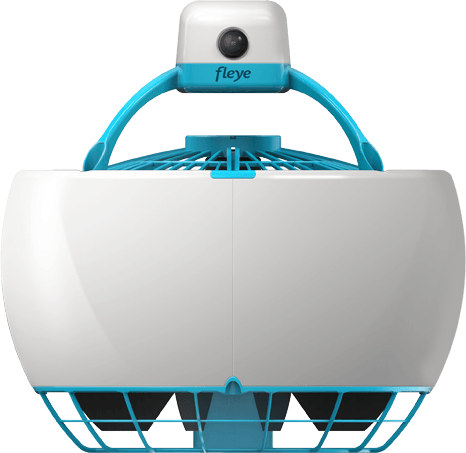In most cases, it’s a pretty bad idea to touch a drone while it’s flying, as you could potentially hurt yourself and others with the blades, so a startup based in Belgium has decided to design a safe drone with the blades hidden under a shell surrounded by protective grids, and with features such as obstacles avoidance. The design also makes the drone sturdier, and less prone to breakage should it fall or hit obstacles. The drone, dubbed Fleye, is based on NXP i.MX6 dual core processor, runs a Linux OS built with the Yocto Project, and the company also plans to provide APIs, and mobile SDKs to allow the developer community to experiment with the drone, and/or create mobile apps.
 Main hardware features of Fleye drone:
Main hardware features of Fleye drone:
- SoC –
FreescaleNXP i.MX6 dual or quad core ARM Cortex A9 processor @ 800 MHz with Vivante GPU - System Memory – 512 MB (1GB as option)
- Storage – micro SD slot
- Connectivity – WiFi up to 100 meters range
- Camera – 5MP camera up to 1080p @ 30 fps (omnivision 5640 sensor)
- Sensors – 3-axis accelerometer, gyroscope, magnetometer, sonar, optical flow tracking via bottom camera, altimeter, and GPS
- Flight – 15 km/h max speed; 8km/h wind tolerance; -/+ 10 cm hovering precision
- Battery – 1,500 mAh LiPo battery with XT60 connector; good for 10 minutes of flight time
- Dimensions – 23 cm diameter
- Weight – 450 grams
The Fleye will ship with a dual core processor, but a special Developer Edition will come with NXP i.MX6 Quad and 1GB RAM instead. The drone is flown with a mobile app running on iOS and Android, and does not require piloting skills, and you just need to select a camera mode such as selfie or virtual tripod before watching the video stream on your mobile device. It’s also possible to control it manually with a virtual gamepad, or an actual Bluetooth gamepad for more control. Since the blade are not exposed, the drone can be pushed around if it is on the way. You can find out more in the video below.
The board uses OpenCV for its obstacle avoidance algorithm, and some more complex apps can be accelerated with OpenGL or/and OpenCL thanks to Vivante GPU. The full APIs and SDKs have not been publicly released yet, but here what you may expect:
- JSON-over-UDP API to control the drone over WiFi from any network capable computing device.
- Android & iOS SDK
- Nodejs and/or Python SDK
Since the main board runs Linux, you’ll be able to write your own applications, and access it via SSH. A different API will also be provided in order to instruct the auto-pilot to take off, land, go to specific GPS coordinated, etc… from your own application(s).
Fleye drone is on Kickstarter, and so far has raised around 100,000 Euros out of its 175,000 Euros target. The super early bird rewards are all gone, but some early bird rewards are still available, and a 699 Euros (~$738) pledge, shipping included, will hopefully get your the drone in September 2016. You may also find more details on gofleye.com and their blog.

Jean-Luc started CNX Software in 2010 as a part-time endeavor, before quitting his job as a software engineering manager, and starting to write daily news, and reviews full time later in 2011.
Support CNX Software! Donate via cryptocurrencies, become a Patron on Patreon, or purchase goods on Amazon or Aliexpress




